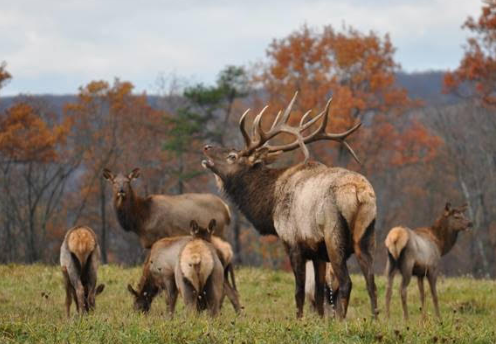Hear the Roar…. Errr… Bugle of the Pennsylvania Wilds
By Emily Just
Autumn is one of my favorite seasons for many reasons- cooler weather, apple pie, leaf peeping. But the bugling of elk in rut really signals the start of the next season.
The elk rut is triggered by photoperiod (day length) and generally begins around the middle of September and carries through early- to mid-October. At its peak from mid-September to mid-October, the elk rut is a time when male elk, or bulls, vie for the hearts of their female counterparts, known as cows. Their goal is to prove their prowess and win the fidelity of a “harem” of females. [Photo at right provided by PA DCNR Bureau of Forestry]

The Pennsylvania Game Commission (PGC) estimates the PA elk herd at roughly 1,000 individuals, a population occupying at least eight north central counties over a range of 3,500 square miles. The PGC has timed the annual elk hunting season (early to mid-November) to miss most of the rut period, ensuring an adequate breeding window.
If you’ve never heard the bugle of the bull elk during the fall rutting period, you are in for an experience that is at once thrilling and haunting. The sound of a bull elk bugling is something that draws many visitors to Elk Country, for it is an experience as memorable as anything you are likely to have in the PA Wilds. In most cases, the bugle starts low and throaty, rising to a high whistle, then dropping to a grunt or a series of grunts. It’s a sound that is difficult for the human to imitate, a guttural bellow, a shrill pitch, and a hollow grunting. “A-a-a-a-a-a-a-a-eeeeeeeeeeeeee-oh. Ee-uh. Ee-uh. Ee-uh.” Or something like that!
While the elk rut is spectacular to hear, it can also be thrilling to watch (from a very safe distance). Bull elk battle it out with rivals, joining antlers and pushing and shoving. Battles don’t often end in serious injury as the weaker bull usually breaks off the confrontation and trots away. Although this can be captivating to watch, remember that during this time bull elk are full of testosterone and can be extremely aggressive.
I highly recommend visiting the PA Wilds during this incredible time of year, but during your visit be safe, considerate and respectful!
For more tips and information on the Pennsylvania elk range visit the PA Great Outdoors Visitors Bureau.
For more information on PA elk and safety tips, visit the PGC Elk Webpage, which includes a live stream from Elk Country.
About the Author: Emily Just is a Wildlife Ecologist in the Bureau of Forestry at the PA Department of Conservation & Natural Resources (DCNR). She has worked for DCNR for over nine years, holding a B.S. from James Madison University and an M.S. in Applied Ecology and Conservation Biology from Frostburg State University. Emily’s favorite areas of study are biodiversity and applied ecology. Emily resides in Linglestown and enjoys hiking and horseback riding in her spare time. This article was originally written for the Bureau of Forestry’s Forest Fridays e-newsletter. Learn more about the Bureau of Forestry here.



